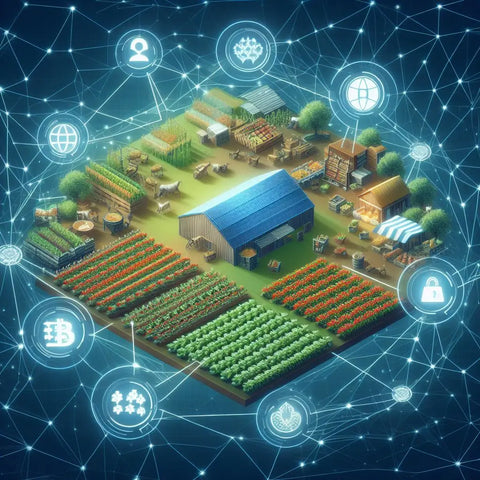Meeting Consumer Demand in Agriculture
Blockchain for Transparent Community-Supported Agriculture
Community
In the world of agriculture, which is constantly changing at a very fast pace, consumers are now seeking more information and tend to be more aware and demanding when it comes to the food they eat. This demand has been the root of some community-supported agriculture projects, which are models that link farmers directly to their local neighborhoods. On the other hand, despite the challenges in the traceability and verification of produce within a CSA, this can be an obstacle in the process of establishing trust between the farmer and the consumer and also strengthening the relationships that exist between them. Blockchain for Community Supported Agriculture (CSA) Transparency is your one-stop-shop for all things technological revolution that can drastically change and improve upon the ways in which we view food traceability and sustainability strategies.

Blockchain for Community-Supported Agriculture (CSA) Transparency:Blockchain for Community-Supported Agriculture (CSA) Transparency:
The blockchain, the underlying technology that uses distributed ledgers, is designed to remedy the difficulties of CSA producers. Blockchain may be an asset in the way it helps farmers and CSA teams create a visible and trustworthy record that tells the product’s history from when it was a seed until it ends up on a table. This digital route creates an opportunity to reach consumers at the final point of delivery and inform them in detail about the place of origin, production processes, and distribution methods of their food, which was impossible before.
Streamlining CSA Operations:
Implementing blockchain technology in community-supported agriculture (CSA) will automate All the procedures like farm-to-table transactions, payments, and so on. Blockchain functionalities that simplify daily farm management through automation of record keeping, invoicing, and payments can cut down on the laborious tasks related to the administration of CSA programs, cutting back farmers’ resources to focus on the central objective of growing high-quality, sustainable food.
Traceability and Transparency:
The increasing blockchain transparency within the context of community-supported agriculture (CSA) means providing clear, open, and verifiable evidence to the sources of commodities from the hoe to the sale point. Every aspect of the process dealing with seed selection, harvesting, packaging, distribution, and sales is registered in the blockchain, and it is impossible to hide or change any of the data in even one single step. Every consumer has access to an immutable and transparent history. It is at this level of transparency that farmers build up a relationship of trust with the community as well as a system that is able to identify and resolve any issues that may arise when and where they happen.
Enhancing Food Safety:
Under the circumstances of a food safety problem occurring, blockchain for community-supported agriculture (CSA) transparency is the right instrument that saves people time collecting the necessary information and isolating compromised products. Through a digital version of the supply chain that is contained in a detailed blockchain record, recalls can happen faster and be targeted, which, in the end, helps minimize the harm done to the community at large and ensure the safety of the produce consumed.
Supporting Sustainable Practices:
The potential of blockchain in the agricultural landscape is not limited to Community-Supported Agriculture (CSA) transparency. It can also be utilized to develop systems of sustainable farming that will revolutionize agriculture. By transmitting the supplies of eco-friendly inputs, the way to conserve water, and other similar eco-friendly efforts made, it can be instrumental in making CSA farmers demonstrate their unfailing care for the environment and have the consumers support the practices through their purchase decisions.
Strengthening Community Connections:
Untap the hidden opportunities for community-supported agriculture (CSA) using blockchain transparency, which can be effectively applied as a tool for building stronger relationships between farmers and their local communities. The blockchain technology establishes a communication channel that is direct and clear for consumers, thus building a shared sense of ownership and interest in the farm. This is achieved because a community of people mutually invests in the farm in their locality.
Conclusion:
As an increasing number of customers call for more transparency and integrity in the food system, the blockchain goes further to propose CSA Transparency as a transformative solution. Utilizing distributed ledger technology, the concept of CSA farmers and organizers is that it can be used to build trust, streamlining the processes in an attempt to increase the quality of food by promoting sustainable practices and thereby strengthening community networks. CSA is gaining much mainstream popularity among food buyers as it adopts blockchain. This trend is going to be a game changer for our whole approach to local, sustainable food production and distribution. This is not just another technique for revolution; it is an infinite revolution to sustain the local food economy.

FAQs
What is the mechanism of blockchain for the transparency of community-supported agriculture (CSA) projects?
CBAS: Blockchain applied to community-supported agriculture (CSA) The transparency system spans the entire supply chain, beginning with the seed and ending with the table, by making use of the blockchain distributed ledger technology's transparent and safe record. Everything is being recorded on a blockchain, starting with planting and harvesting, packaging, and distribution, which, as a digital trail, anyone wanting to know how their product was produced can follow.
Why is the Blockchain CSA-System so important?
The key benefits of blockchain for community-supported agriculture (CSA) transparency include: The key benefits of blockchain for community-supported agriculture (CSA) transparency include:
• The enhanced visibility and trackability of the food supply chain result in more transparency.
• The exactness and speed of discovery are being improved due to food safety and the detection of problems.
• The boost of sustainable farming management programs, including education and assistance to farmers, is essential to our mission.
• The CSA will implement more practical and quick administrative processes for farm operations.
• Farmers, acting not only as nutrition suppliers but also as local identity creators, will benefit from thoughtful connections, especially between farmers and their local communities.





Leave a comment